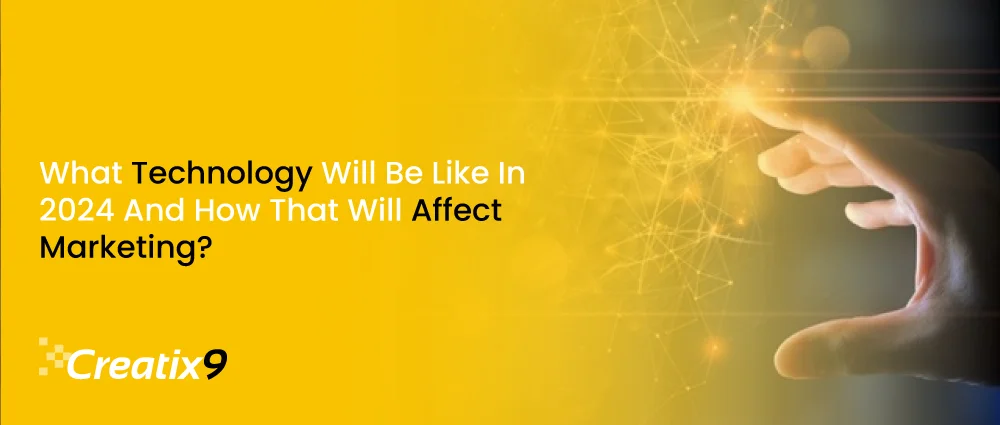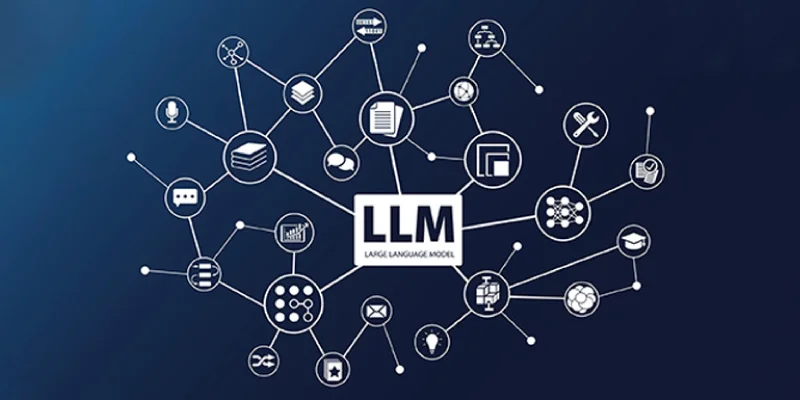
As we approach 2024, it is awe-inspiring to observe the rapid progression of technology. Daily, novel developments occur that not only stimulate our interest but also profoundly convert how we operate, collaborate, and conduct business.
Understanding these technological trends is particularly important for us marketers to remain ahead of the curve rather than simply keep pace with the times. Capturing and adjusting to these fluctuations is paramount when developing strategies that effectively connect with our target audiences and capitalize on the most recent technological advancements.
1. A Switch To Remote Work

2024 will change labor dynamics, particularly within the technology sector. The era of complete remote work, with a huge surge in popularity over the last few years, is losing more fame. Presently, a shift is occurring toward hybrid employment models.
The primary push behind this move is the requirement for better collaboration and synergy, which frequently blooms in this digital age. Former proponents of the remote work revolution, technology companies are now endorsing a more balanced approach in which workers divide their schedules between the workplace and their residences.
Effects on Workplace Collaboration and Marketing Strategies
Significant ramifications for collaboration and marketing strategies in the workplace accompany the change from remote to hybrid work structures.
Bringing back physical workspaces can help people collaborate more naturally and spontaneously, which is lacking in remote setups. Marketers can utilize this restored energy for brainstorming sessions, generate creative ideas, and develop more unified campaign plans.
Maintaining the flexibility and individual productivity of remote work is the task. To adapt to a decentralized workforce, marketers need to adjust their approaches. For smooth communication and project administration, they can use digital tools.
It is now possible to create a marketing campaign that appeals to remote and in-office workers’ preferences, and understanding the evolving consumer behaviors that reflect this change in organizational culture is crucial.
Appreciating the cooperative ethos of traditional office environments while keeping in mind the adaptability and ingenuity that remote work enables is essential for marketers to maintain a balance.
Utilizing the hybrid model can help one understand and comprehend the dynamic market.
2. The Surge of large language models (LLMs) and autonomous agents

As we adjust to evolving work environments in 2024, autonomous agents and large language models (LLMs) will emerge as an additional significant technological trend. This development unquestionably represents a paradigm shift in how marketing, among other industries, approaches and executes tasks.
The addition of New Programming Frameworks and large language models (LLMs)
Central to this movement are the recently developed programming frameworks designed to integrate enterprise applications with extensive language models in a seamless manner.
In simplified language, what does this imply? LLMs are intelligent, highly developed systems capable of comprehending and producing text that resembles that of humans. These models can analyze extensive volumes of data, identify patterns, and generate predictions by utilizing the information they process.
Enterprise application integration of these models unlocks an inexhaustible array of opportunities. An illustration of this is how an LLM can augment a marketing analysis tool, enabling it to collect data and deliver actionable insights and recommendations in an intuitive format for marketers. This integration facilitates an interactive and user-friendly technological experience, translating intricate data into practical insights.
Applying Autonomous Agents in Marketing/Advertising
The utilization of autonomous agents, led by these developments, can fundamentally alter the way marketers operate. These agents have AI and machine learning functionalities. These can execute a diverse array of tasks independently, including but not limited to complex project planning, content generation, and administrative responsibilities.
Marketers must adapt to this change and restructure how they administer and implement campaigns. Programming autonomous agents to perform repetitive duties like reporting, scheduling, and even preliminary market research is possible.
Marketers can allocate more time toward strategic decision-making and innovative efforts. It only requires human involvement in geographic elements of marketing.
The content-creation potential of autonomous agents is excellent; producing preliminary designs for marketing materials, generating creative concepts, and outlining content are also tasks these agents may help with.
By analyzing campaign data from the past, they can recommend content strategies likely to align with aim audiences. They can streamline the content creation process and make it data-driven.
The emergence of independent agents and LLMs is impressive and signals an advancement in how technology can enhance the marketing procedure. By adopting these tools, marketers can augment their ingenuity, optimize their operations, and maintain a competitive edge in a challenging market.
3. Generative AI as the Next Generation of Video Games
A significant paradigm shift is imminent within the video gaming sector, predominantly propelled by the incorporation of generative artificial intelligence. Not only does this integration improve the overall gaming experience, but it is also bringing about a paradigm shift in the development and interaction of video games.
Video Games are getting better Based on players’ efforts

A more flexible and adaptable model replaces the old video game structure, letting players have more choices and follow a different path. Video game development has a user input influence due to generative AI. In a dynamic gameplay experience, the game’s narratives, characters, and environment can be modified and adapted in real time based on the player’s actions and choices.
Imagine interacting with NPCs whose dialogue seems to offer infinite options instead of being limited to predetermined phrases. Picture a game that customizes unique stories and challenges to match the preferences and likes of each player.
Generative AI enables a high degree of customization and interaction by dynamically generating diverse and intricate content, infusing each gaming experience with its own identity.
AI-Focused Interactive Gaming Atmospheres gives Marketing Opportunities.
This gaming revolution now has opportunities for marketers. Ideal personalized and immersive marketing strategies involve implementing generative AI-powered interactive gaming environments. Brands can generate a level of engagement. Conventional advertising is no match for this. By customizing in-game experiences for each user, they can do so.
You can smoothly integrate in-game advertising into the narrative and gaming environment. Advertisements can become more relevant and less disruptive by tailoring them per the player’s in-game actions and decisions. You might not even notice that they’re promoting a product in some games. Sometimes, the game features cool missions or tasks centered around a specific brand.
Using these gaming environments to conduct market research presents a promising opportunity. Marketers can acquire valuable knowledge of consumer preferences and behaviors by examining player interactions with various game elements. This knowledge can also benefit marketing plans and campaigns outside the gaming sector.
Not only is the integration of generative AI into video games transforming the gaming industry, but it is also establishing an entirely new domain for marketing. By utilizing these interactive environments powered by artificial intelligence, marketers can interact with audiences in unprecedentedly personalized, immersive, and influential ways.
4. The shift toward authentication without a password

The transition from conventional password-based authentication to more secure and user-friendly passkeys is a notable security paradigm shift. This evolution addresses the growing demand for robust digital security and seamless user experiences; it is not merely a technical enhancement.
Change of Using Passkeys rather than Passwords
Although the conventional password system is widely employed, it has consistently encountered challenges. Passwords are susceptible to brute-force attacks, are readily guessed, and frequently fall victim to phishing scams. Due to these vulnerabilities, the technology sector is shifting its focus towards passkeys.
Passkeys signify a paradigm shift in authentication, providing heightened levels of security while maintaining simplicity. Passkeys constitute a form of two-factor authentication in which the transaction needs validation instead of passwords. Bluetooth-enabled confirmation, PINs, biometric data, or secured devices are best applicable.
The outcome is a user-friendly and more secure authentication process, which decreases the probability of security breaches and enhances users’ overall satisfaction.
A Game-Changer for Marketers: data protection and client trust
Due to this shift, marketers face importance regarding data protection and building consumer trust. Protecting consumer information is crucial in an era where data breaches are rising. Reassuring clients that their confidential information is secure can bolster the brand’s overall credibility, and passkey adoption can assist marketers in doing so.
Passkeys may empower marketers to investigate marketing strategies that are more individualized and data-centric. A high level of security they can have. Increasing customer confidence in disclosing confidential information is reachable with a more robust security framework. More focused and productive marketing campaigns are possible with enhanced client data for markers or promotors.
Passkeys can ensure a smooth user experience (UI) and better client interactions with digital platforms, like websites, apps, and online services. It is a must to optimize the authentication process to minimize obstacles, increase user involvement, and ultimately result in higher conversion rates.
For marketers, the change towards passkey (password-less authentication) is a strategic opportunity, not just a technical change.
5. Quantum computing and its revolutionary capacity

Quantum computing is one of the most intriguing technological developments capturing the attention of the tech community. This represents not merely an emerging form of computation but rather an entirely novel methodology that holds the potential to transform how information is processed.
A grasp of quantum computing
Traditional computing is fundamentally distinct from quantum computing. In contrast to classical computers, which process data using bits (0s and 1s), quantum computers utilize qubits or quantum bits. The simultaneous existence of these qubits in multiple states is made possible by quantum mechanical principles. Consequently, quantum computers can execute intricate computations at velocities that are presently unattainable.
Infinite potential exists for quantum computing. It can perform calculations in seconds that would take years for today’s most powerful supercomputers to complete. This encompasses the resolution of complex mathematical dilemmas as well as the simulation of molecular structures in the context of pharmaceutical research.
The Influence Of Quantum Computing On Marketing
With the rise of quantum computers, marketers face new opportunities and challenges. How data is analyzed, and methods for reaching customers will significantly change.
Quantum computing is more efficient at analyzing enormous datasets than existing technologies. Marketers must understand consumer preferences, trends, and behavior at a rate and size that has never been seen before. With this, they can improve predictive modeling. It gives more precise forecasting of market trends and customer requirements.
Quantum computing could be a game-changer for making marketing at a more personal level. Marketers or Promoters can create super-customized campaigns that speak to each person’s likes and interests— better engagement and more people buying stuff because the ads are right for them.
However, marketers must reconsider their existing data strategies to prepare for the effects of quantum computation. Before anything else, they must learn quantum computing and its possible usage in their industry. They should also look into teaming up with quantum computing companies and experts to stay ahead of the competition.
When planning the ethical consequences of such sophisticated data analysis capabilities, marketers should consider them. Quantum computing lets us dig deep into data, so it’s essential to ensure we keep customers’ privacy and trust safe.
Marketers can get the most from quantum computing, such as advanced data analyses to analyze complex consumer behavior patterns, identify trends, and derive insights from massive datasets in real-time. They can have optimized campaigns. Marketers can distribute resources better using optimization algorithms and accurately target the audiences they want to capture. Thus, they can enhance ROI. Also, they can have predictive analytics where they can process big data sets and do complex calculations for the predictions of customers’ behaviors very correctly. Marketers can detect fraud via advanced encryption techniques to shore up cybersecurity measures.
6. Utilizing Internet Traffic from Home Devices

Looking further into the technological race for 2024, we find an exciting development: it is predicted that over 50% of residential internet traffic will come from appliances and other gadgets in the home. It is proof of the growing normalness of the Internet of Things (IoT) in our daily lives and its high influence on the marketing sector.
The Rise in Smart Home Devices That Can Connect
Not too long ago, it didn’t appear very certain that refrigerators, thermostats, security systems, and toasters could generate major internet traffic. But now, with the rise of smart home devices, their impact on our internet ecosystem gets a high-five.
With the constant sending and receiving of data, these gadgets operate efficiently, making them more accessible for people to use, and you can add extra features.
As a result of this spread, the usual household is no longer a central location for traditional internet activities like browsing websites and watching streaming videos. Now, every device in the network, like smart TVs and thermostats, creates data with the amount of internet traffic going through the house.
Marketing Opportunities of Smart Home Devices and IoT
A lot of marketing opportunities are now open due to this change. Opened up by the Internet of Things (IoT) and smart home devices is a new way to collect data and connect with customers. Real-time insights into consumer behavior, preferences, and lifestyle patterns are now possible.
Customize marketing communications by using data from an interconnected thermostat or smart refrigerator. Marketers can quickly tell the difference between the optimal time to heat a household and when specific supplies tend to run out with this method; highly targeted and timely advertising campaigns can be carried out.
The devices’ interactive characteristics present novel opportunities for direct consumer interaction. Through these platforms, brands can provide additional services or content and create custom apps or skills for smart devices. Picture a scenario where a home security system suggests insurance products, just like a cooking app recommending recipes based on the ingredients in your fridge.
Marketers find it crucial to integrate their messages and services flawlessly into the IoT ecosystem with methods. Marketers can prioritize delivering value and convenience to consumers instead of merely promoting advertisements. They can smoothly integrate consumers’ routine interactions with their smart home devices.
Reaching more specific and valuable marketing possibilities through the rise of IoT devices and home appliances causing increased internet traffic is not just a passing trend. Connecting more meaningfully with customers is possible for marketers who use this trend.
Developments In Health Tech
Besides the IOT and quantum computing surrounding 2024, wellness tech has grown immensely. The “advanced prosthetics” and “accurate healthcare system” have given a new potential to medical care and marketers active in this sector.
Emerging Healthcare Trends
Within the healthcare industry, precision medicine has emerged as a big trend. Considering a patient’s environmental settings, genetic composition, and way of life, this approach customizes medical interventions to fit their unique traits. Refining healthcare’s success through personalized techniques that reform treatments and outcomes is now achievable.
Sophisticated prosthetics have seen another notable progress. Fake body parts gets better in the last few years. Not only do they function like real ones, but now they can also feel like the real ones! By attempting to amplify the intense nature of the human spirit, this advance aims to defeat physical restrictions.
Marketing Potential: Personalized Health Tech and Wellness Innovations in 2024
These technological advances in wellness care create an abundance of opportunities for marketers. Advanced prosthetics and an accurate healthcare system can give more individualized wellness solutions—a new domain for executing targeted marketing strategies.
Collaborating with doctors and healthcare companies, we can create unique ads—advertisements of customized treatments to inform the audience on how to receive them. In partnership with genetic testing companies, promote products and services that match someone’s health details.
These technological developments can give better power to the wellness sector. With a mixture of data from prosthetic technologies and accurate healthcare, marketers can meet the specific wellness needs of each client. Wellness organizations can provide more individualized products and services, such as nutrition guides and customized health programs.
With these tech improvements, marketers can make impactful campaigns in the wellness industry. Personalizing experiences, telling stories, and bringing people together in communities are what they can focus on.
CLOSING WORD
2024 is live, and this year has come with many new techs, from the change of office to emote work to big changes in wellness tech. These all allow marketers to boost the marketing field further, along with some challenges.
For marketers, this blog is about guiding principles for adaptation. Keeping an open and flexible mindset is more important now than ever before for them.
The discussed techs in a blog review creative approaches to market a product or service and an ongoing pursuit of knowledge regarding the growing digital world.
Marketers must perceive these developments as prospects to establish deeper connections with their target audiences. The improvement of interaction, customization, and confidence is all they can do. Innovative marketing strategies have vast potential, whether using IoT data, AI-driven content, or quantum computation.
In 2024, the most important thing for marketers to do is adapt, lead, and fully hold how technology can change marketing.

